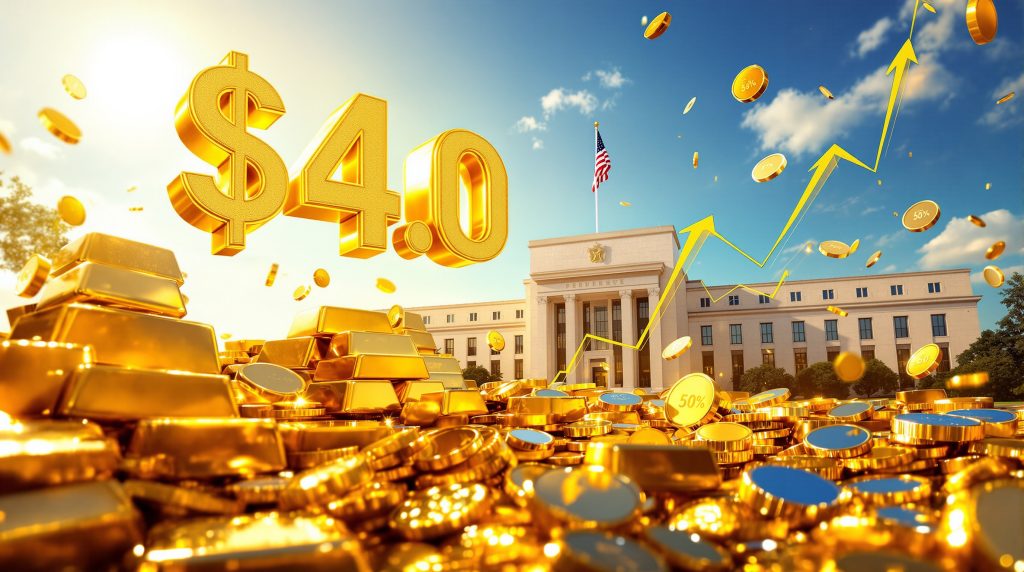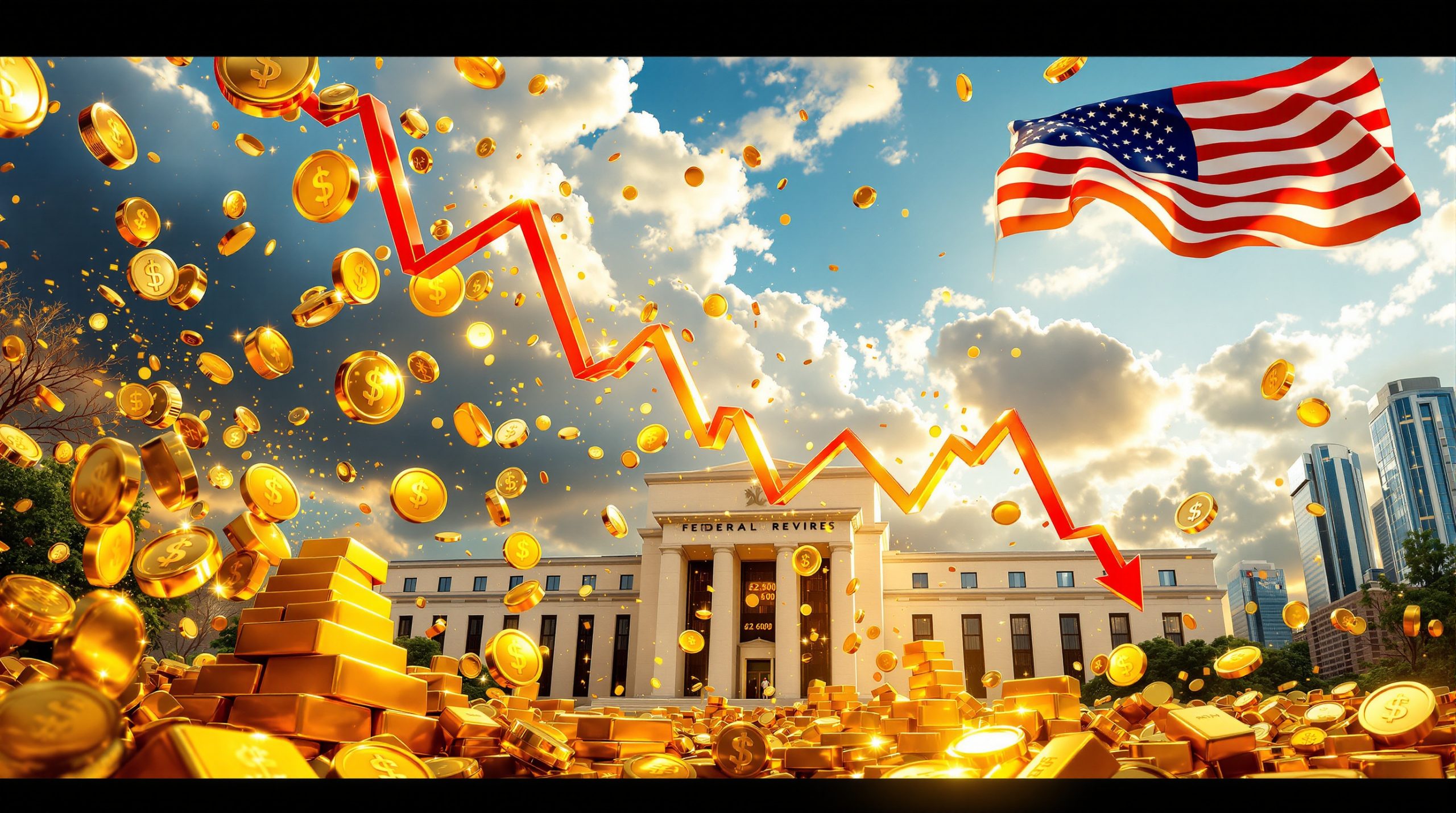Federal Reserve Rate Cuts: The Primary Catalyst Behind Gold's Momentum
The Federal Reserve's aggressive monetary easing has emerged as the cornerstone supporting gold rebounds above 4000 fed prepares rate cut scenarios throughout 2025. Following a series of rate reductions totaling 50 basis points, the central bank has positioned its benchmark rate within the 3.75%-4.00% range, with financial markets assigning overwhelming confidence to continued accommodation.
Market participants are currently pricing in a 99% probability of another quarter-point reduction, reflecting unprecedented consensus around the Fed's dovish trajectory. Furthermore, this monetary policy shift creates multiple transmission mechanisms that directly benefit precious metals positioning, as outlined in our comprehensive gold all-time highs analysis.
Key Federal Reserve Policy Impacts:
• Dramatically reduced opportunity costs for holding non-yielding assets like gold and silver
• Compression of real yields making traditional fixed-income investments less attractive
• Systematic dollar weakness amplifying international investor appetite for precious metals
• Enhanced inflation hedge positioning as monetary accommodation continues expanding
The mathematical relationship between interest rate policy and gold valuations has proven particularly pronounced during this cycle. Each 25 basis point reduction correlates with substantial upward pressure on precious metals, as investors recalibrate portfolio allocations away from yield-bearing instruments toward tangible stores of value.
Market Expectations for Extended Monetary Accommodation
Forward guidance from Federal Reserve communications suggests the easing cycle will extend well into 2026, creating a multi-year tailwind for precious metals accumulation. This extended timeline has fundamentally altered institutional investment strategies, with pension funds, endowments, and sovereign wealth funds increasing precious metals allocations as portfolio stabilizers.
The central bank's shift toward prioritising employment stability over inflation control marks a significant departure from previous monetary frameworks. Consequently, this creates structural support for non-yielding assets that historically perform well during periods of currency debasement, particularly when considering gold as an inflation hedge.
Economic Uncertainty Reshaping Investment Demand Patterns
Beyond Federal Reserve policy considerations, fundamental economic disruptions are driving unprecedented demand for safe-haven assets. The emergence of what labour economists characterise as a targeted recession affecting professional services has highlighted vulnerabilities in previously stable employment sectors.
Employment Market Transformation:
• Professional services unemployment climbing from 3.1% to 4.0% within a single year
• Major corporations announcing significant workforce reductions, with Amazon cutting 14,000 corporate positions
• Target eliminating approximately 1,000 corporate roles as part of operational restructuring
• Average job search duration for senior professionals extending to six to nine months
• 40% of white-collar applicants receiving zero interview opportunities throughout 2024
These employment dynamics represent more than cyclical adjustment; they reflect structural changes in how corporations organise work. Research indicates that one in four American workers who lost positions in 2024 worked in professional and business services, while blue-collar industries like manufacturing and healthcare maintained steady hiring patterns.
Technology Displacement Creating Investment Uncertainty
The acceleration of artificial intelligence adoption across corporate operations has created unprecedented uncertainty regarding future employment patterns. Industry analysis suggests 70% of white-collar tasks face potential transformation or replacement through AI implementation, fundamentally altering traditional career trajectories.
According to employment market research, hiring for positions with salaries exceeding $125,000 declined 32% compared to previous years, reflecting corporate preference for technology solutions over high-cost human capital. This technological displacement has intensified concerns about economic resilience, driving portfolio diversification into tangible assets that maintain value during periods of structural adjustment.
| Employment Sector | Unemployment Rate Change | Hiring Trend |
|---|---|---|
| Professional Services | 3.1% → 4.0% | Declining |
| Manufacturing | Stable | Steady Growth |
| Healthcare | Stable | Expanding |
| Technology | Variable | AI-Driven Restructuring |
Silver Following Gold's Trajectory with Unique Characteristics
Silver's performance has demonstrated remarkable correlation with gold's movements while benefiting from additional industrial demand fundamentals. The white metal's dual nature creates positioning advantages that extend beyond pure monetary considerations.
Following the Federal Reserve's most recent policy announcement, silver rebounded 2.5% after experiencing a 3.8% decline during trade-related market volatility. This volatility pattern mirrors gold's behavior while exhibiting slightly amplified price swings characteristic of smaller, more liquid markets.
Silver Market Performance Metrics:
• 2025 year-to-date performance: +42%, closely tracking gold's trajectory
• Industrial demand providing baseline price support during market corrections
• Gold-to-silver ratio dynamics creating potential mean reversion opportunities
• Central bank accumulation patterns beginning to extend beyond gold into silver holdings
The white metal benefits from what commodities analysts term a "dual demand profile"—responding simultaneously to monetary demand from investors seeking inflation protection and industrial demand from sectors including electronics, solar energy, and medical applications.
Industrial Applications Supporting Price Fundamentals
Silver's extensive industrial applications create demand floors that don't exist for purely monetary metals. Electronic components, photovoltaic cells, and medical devices require consistent silver inputs regardless of investment demand fluctuations, providing structural support during market corrections.
This industrial demand profile becomes particularly significant during periods of economic expansion. In addition, when manufacturing activity can offset reduced investment demand, the metal's conductivity properties and antimicrobial characteristics make it irreplaceable in numerous high-growth industries.
Geopolitical Tensions Providing Fundamental Support
International conflicts and diplomatic uncertainties continue generating baseline demand for precious metals as portfolio insurance. Recent developments in US-China relations, alongside ongoing trade negotiations and military conflicts, maintain elevated risk premiums across global financial markets.
Geopolitical Risk Factors:
• Escalating tensions between major economic powers creating currency uncertainty
• Trade policy volatility affecting global supply chain reliability
• Military conflicts generating supply disruption concerns
• Diplomatic negotiations failing to provide lasting stability
These international considerations have prompted both individual investors and institutional fund managers to increase precious metals allocations as portfolio stabilisers. The reliability of gold and silver during periods of geopolitical stress has proven itself across multiple decades of international crises, influencing the complex gold stock market relationship dynamics.
Central Bank Gold Accumulation Trends
Global central banks have emerged as significant net purchasers of gold reserves, with acquisitions reaching multi-decade highs. This institutional demand creates structural price floors while signalling official sector confidence in precious metals as monetary assets.
Central bank purchases differ from investor demand in important ways: they represent permanent removals from available supply, are typically price-insensitive, and signal official recognition of precious metals' monetary properties. This institutional validation provides credibility for individual investor positioning strategies.
"Central bank gold accumulation has averaged over 400 tons annually in recent years, representing systematic diversification away from traditional reserve currencies and toward tangible monetary assets."
Sustainability of Gold's Rally Above $4,000
Historical analysis of precious metals bull markets suggests the current rally exhibits characteristics consistent with sustained upward momentum rather than speculative excess. Gold's most significant bull markets typically span multiple years, with periodic corrections providing consolidation opportunities rather than trend reversals.
Sustainability Indicators:
• Broad-based demand across multiple investor categories and geographic regions
• Fundamental monetary policy support extending through multiple policy cycles
• Structural economic uncertainties persisting across developed economies
• Limited new supply additions constraining available inventory
The current rally shares several characteristics with gold's historic 1970s bull market, which delivered exceptional returns during a period of monetary expansion and geopolitical instability. However, today's market benefits from more sophisticated investment vehicles and broader institutional participation than previous precious metals cycles.
Comparing Current Conditions to Historic Precedents
The 1979 gold surge of 125% occurred during a period remarkably similar to current conditions: expansionary monetary policy, elevated inflation concerns, currency debasement fears, and significant geopolitical instability. Today's market environment exhibits these same fundamental drivers while benefiting from enhanced accessibility through exchange-traded funds, digital platforms, and institutional investment products.
Modern precious metals markets also feature more sophisticated price discovery mechanisms and global participation. Consequently, this potentially supports more sustained appreciation cycles compared to the sharp boom-bust patterns of previous decades.
Strategic Positioning for Gold Above $4,000
Investment positioning at current price levels requires understanding both the opportunities presented by continued monetary accommodation and the risks associated with elevated valuations. While gold has reached historic highs, multiple fundamental factors suggest continued upward potential, as detailed in our best gold investment strategies guide.
Portfolio Positioning Strategies:
• Dollar-cost averaging to manage short-term volatility while building long-term positions
• Physical metals allocation for wealth preservation and monetary insurance
• Mining equity exposure for leveraged participation in precious metals appreciation
• Balanced precious metals allocation between gold and silver to optimise risk-adjusted returns
Strategic investors should focus on long-term wealth preservation objectives rather than short-term price speculation. The convergence of monetary policy support, structural economic changes, and geopolitical uncertainties provides compelling justification for maintaining precious metals exposure.
Risk Management Considerations
Despite bullish fundamental conditions, investors must maintain realistic expectations regarding short-term price movements. Gold's historical tendency toward sharp corrections during bull markets necessitates appropriate position sizing and risk management protocols.
Risk Management Guidelines:
• Limit precious metals to appropriate portfolio percentages based on individual circumstances
• Maintain diversification across multiple asset classes
• Avoid leveraged exposure that could force liquidation during temporary corrections
• Focus on physical ownership and direct exposure rather than derivative instruments
Future Outlook as Federal Reserve Policy Evolves
Gold's trajectory through 2026 will largely depend on Federal Reserve policy execution and broader economic developments. Multiple scenarios could influence precious metals performance as central bank accommodation continues, as explored in our detailed gold price forecast.
Potential Market Catalysts:
• Additional rate cuts exceeding current market expectations
• Economic recession requiring more aggressive monetary stimulus
• Inflation resurgence forcing central bank policy recalibration
• Dollar weakness accelerating international precious metals demand
The convergence of monetary, fiscal, and geopolitical factors suggests gold rebounds above 4000 fed prepares rate cut scenarios retain considerable potential for continuation, particularly if economic uncertainties persist and central bank policies remain accommodative.
Technology Sector Implications
The rapid valuation expansion in artificial intelligence companies, exemplified by Nvidia's approach toward $5 trillion market capitalisation, creates potential systemic risks that could benefit precious metals. If speculative technology investments experience corrections similar to previous bubble cycles, flight-to-safety demand could accelerate precious metals appreciation.
Historical precedents suggest that when speculative asset bubbles deflate, investors typically rotate toward tangible stores of value. Furthermore, this creates additional demand beyond fundamental drivers already supporting precious metals markets, as noted by recent market analysis.
Precious Metals in the New Monetary Era
Gold rebounds above 4000 fed prepares rate cut represents a fundamental shift in global monetary conditions rather than temporary market speculation. As central banks worldwide maintain accommodative policies and structural economic changes create persistent uncertainties, precious metals appear positioned for sustained outperformance.
The combination of Federal Reserve policy support, employment market disruption, geopolitical tensions, and technology-driven economic transformation provides multiple reinforcing factors for continued precious metals strength. Investors seeking wealth preservation should consider strategic allocations that reflect these changing monetary realities.
Key Investment Considerations:
• Physical precious metals provide direct exposure without counterparty risk
• Strategic allocation should reflect individual financial circumstances and objectives
• Long-term perspective remains essential given precious metals' historical volatility patterns
• Professional guidance can help optimise positioning strategies for changing market conditions
The gold rebounds above 4000 fed prepares rate cut scenario represents more than a price milestone; it signals fundamental changes in how investors and institutions view monetary assets in an era of persistent currency debasement and economic uncertainty.
"Precious metals investments involve market risk and potential for significant price volatility. Past performance does not guarantee future results. Investors should carefully consider their financial objectives and risk tolerance before making investment decisions."
Ready to Invest in the Next Major Gold Discovery?
Discovery Alert instantly alerts investors to significant ASX mineral discoveries using its proprietary Discovery IQ model, turning complex mineral data into actionable insights for both short-term trading and long-term investment opportunities. With gold reaching historic highs and precious metals demand surging, begin your 30-day free trial today to position yourself ahead of the market and capitalise on discovery-driven opportunities.




